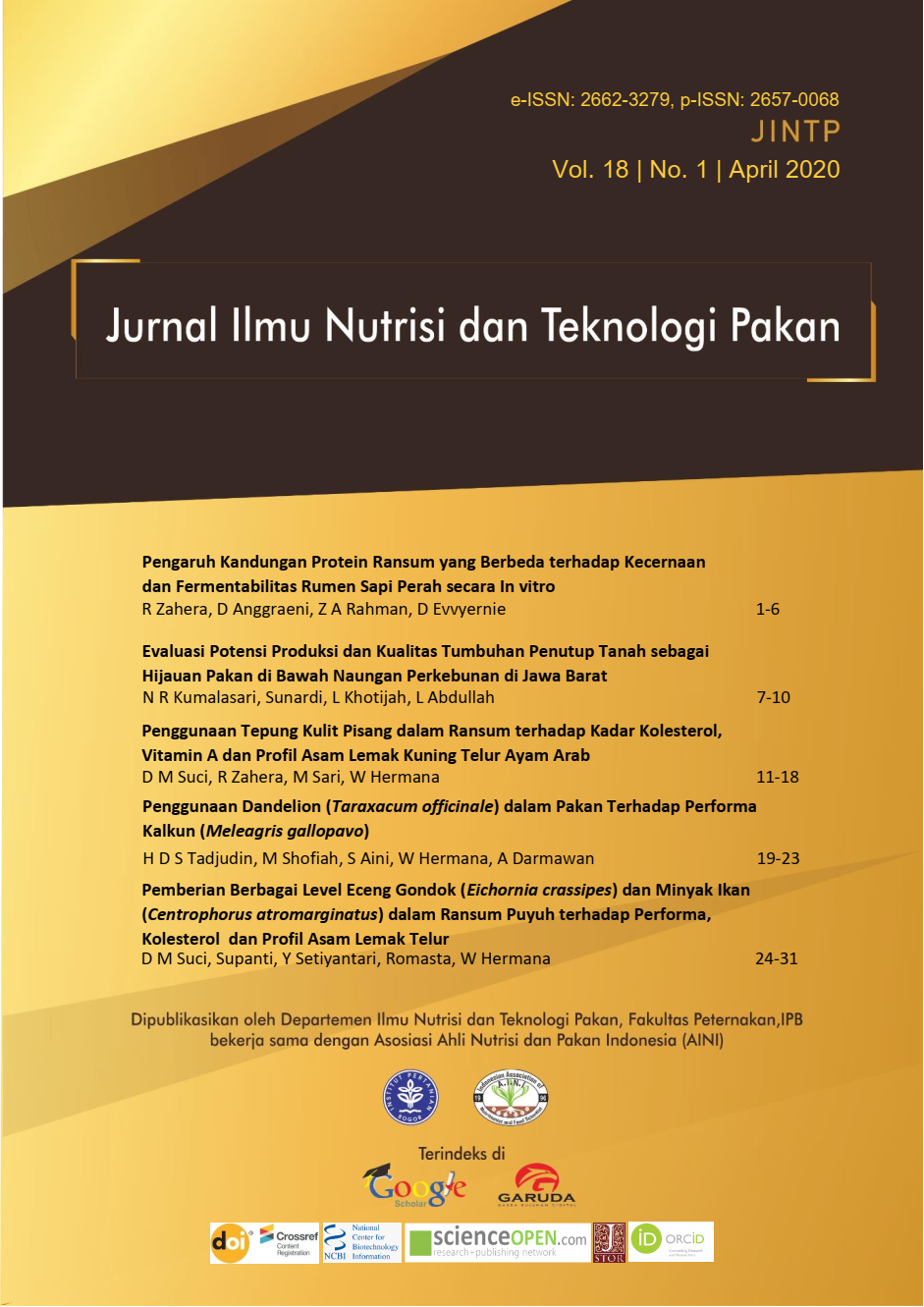Evaluasi Potensi Produksi dan Kualitas Tumbuhan Penutup Tanah sebagai Hijauan Pakan di Bawah Naungan Perkebunan di Jawa Barat
Evaluation of Production and Quality Covercrop as Forage under Plantation at West Java
Abstract
Cover crop diversity under plantation area has potency to supply forage for animal farming. The research aim was to evaluate cover crop vegetation and to estimate plant production and quality under plantation at West Java. This research was conducted from May 2018 to April 2019 at public and private company around Bogor, Banten, Kuningan and Garut. In each area, there were selected 10 plots for plant identification with sample size was 50 cm x 50 cm. Biomass production and nutrient quality was sampled through 3 plots with sample size was 100 cm x 100 cm, forage was harvested and weighed then analyzed by proximate analysis. Diversity and biomass production were analyzed by R 3.6.2 software through Analysis of Variance(ANOVA) based on environment differences, then the significant results analyzed by LSD Test. The results showed that the highest biomass was sampled in Bogor i.e. 359 g m‑2 ±164.08 g m‑2 fresh weight and 71.22 g m‑2 ±45.91 g m-2 dry weight. Cover crop diversity varied around two to 32 species with percentage of area cover around 10-90%. Potential plants as forage were Panicum repens (lempuyangan), Paspalum conjugatum (jukut pahit) and Asystasia gangetica (ara sungsang). Dry matter content of composite forage was 18.3%-31.6%, crude protein was 4.57%-10.8%, crude fiber was 21.3%-25.7% and ashreached 11.2%-15.9%. It can be concluded that cover crop under plantation have potency to supply forage, especially in Bogor, however concentrate addition is needed to fulfil nutrient animal requirement due to the low quality forage.
Key words: biomass, cover drop, diversity, nutrient, plantation
DAFTAR PUSTAKA
Adriadi A, Chairul & Solfiyeni. 2012. Analisis vegetasi gulma pada perkebunan kelapa sawit (Elais quineensis Jacq.) di Kilangan, Muaro Bulian, Batang Hari. Jurnal Biologi Universitas Andalas. 1(2): 108-115
Adigun OS, Okeke EN, Makinde OJ & Umunna MO. 2014. Effect of replacing wheat offal with Asystasia gangetica Leaf Meal (ALM) on growth performance and haematological parameters of weaner rabbits. Greener Journal of Agricultural Sciences. 4 (1): 009-014
Alviyani. 2013. Analisis potensi dan pemanfaatan hijauan pakan pada peternakan domba rakyat Desa Randobawa Ilir, Kecamatan Mandirancan, Kabupaten Kuningan, Jawa Barat. [Skripsi]. Bogor (ID): Institut Pertanian Bogor
Asbur Y, Yahya S, Murtilaksono K, Sudradjat & Sutarta ES. 2015. Study of Asystasia gangetica (L.) Anderson utilization as cover crop under mature oil palm with different ages. International Journal of Sciences: Basic and Applied Research. 19 (2): 137-148
Darmijati S & Syarifuddin AK. 2002. Pengaruh musim tanam terhadap hasil kacang tanah di tipe agroklimat B dan C. Jurnal Agromet. 16 (1-2): 37-48
Daru TP, Yulianti A & Widodo E. 2014. Potensi hijauan di perkebunan kelapa sawit sebagai pakan sapi potong di Kabupaten Kutai Kartanegara. Pastura. 3: 94-98.
Hamdan MA. 2012. Potensi hijauan lokal pesisir pantai bagi ternak ruminansia di Desa Mangunlegi Kecamatan Batangan Kabupaten Pati [Tesis]. Bogor (ID): Institut Pertanian Bogor
Herilimiansyah, Kumalasari NR & Abdullah L. 2019. Evaluasi sistem budidaya tanaman Asystasia gangetica T. Anderson yang ditanam dengan jarak berbeda di bawah naungan kelapa sawit. Jurnal Ilmu Nutrisi dan Teknologi Pakan. 17(1): 6-10.
Jiju V, Gorantla M & Chamundeeswari D. 2013. Evaluation of anthelmintic activity of methanolic extract of Asystasia gangeticum. International Journal of Pharmacyand Life Science. 4 (6): 2727-2730
Mildaerizanti. 2014. Integrasi sapi sawit dan potensinya dalam mendukung pertanian berkelanjutan di Muaro Jambi. Palembang (ID): Prosiding Seminar Nasional. Badan Litbang Pertanian.
Naidu VSGR. 2012. Handbook on Weed Identification. Directorate of Weed Science Research. Jabalpur (IN): Indian Council of Agricultural Research.
[NRC] National Research Council. 2000. Nutrient Requirements of Beef Cattle. Seventh Revised Edition: Update 2000. Washington (US): The National Academies Press
Norlindawati AP, Haryani H, Sabariah B, Noor MI, Samijah A, Supie MJ & Edham ZW. 2019. Chemical composition of weeds as potential forage in integrated farming. Malaysian Journal of Veterinary Research. 10 (2): 19–24
Prasetyo H & Zaman S. 2016. Pengendalian gulma perkebunan kelapa sawit (Elaeis guineensis Jacq.) di Perkebunan Padang Halaban, Sumatera Utara. Buletin Agrohorti. 4 (1): 87-93
Ramdani D, Abdullah L & Kumalasari NR. 2017. Analisis potensi hijauan lokal pada sistem integrasi sawit dengan ternak ruminansia di Kecamatan Mandau Kabupaten Bengkalis Provinsi Riau. Buletin Makanan Ternak. 104 (1): 1-8
Sari HFM & Rahayu SSB. 2013. Jenis-Jenis gulma yang ditemukan di perkebunan karet (Hevea brasiliensis Roxb.) Desa Rimbo Datar Kabupaten 50 Kota Sumatera Barat. Jurnal Ilmiah Biologi: BIOGENESIS. 1(1): 28-32
Setiawan E. 2009. Kajian hubungan unsur iklim terhadap produktivitas cabe jamu (Piper retrofractum Vahl) di Kabupaten Sumenep. AGROVIGOR: Jurnal Agroekoteknologi. 2(1): 1-7
Sisriyeni D & Soetopo D. 2005. Potensi, peluang dan tantangan pengembangan integrasi sapi-sawit di Provinsi Riau. Pekanbaru (ID): Lokakarya Pengembangan Sistem Integrasi Kelapa Sawit-Sapi. Balai Pengkajian Teknologi Pertanian Riau.
Syahputra E, Sarbino & Dian S. 2011. Weeds assessment di perkebunan kelapa sawit lahan gambut. Jurnal Perkebunan & Lahan Tropika. 1: 37-42
Tilloo SK, Pande VB, RasalaTM, & Kale VV. 2012. Asystasia gangetica: Review on multipotential application. International Research Journal of Pharmacy. 3 (4): 18-20
Utomo BN & Widjaja E. 2012. Pengembangan sapi potong berbasis industri perkebunan kelapa sawit. Jurnal Penelitian dan Pengembangan Pertanian. 31 (4) : 153-161
Wiyono DB, Affandhy L, Rasyid A. 2003. Integrasi Ternak dengan Perkebunan Kelapa Sawit. Bogor (ID): Prosiding Lokakarya Nasional Sistem Integrasi Kelapa Sawit-Sapi. Pusat Penelitian dan Pengembangan Peternakan
Wigati S, Maksudi & Wiyanto E. 2016. The use of rubber leaves (Hevea brasiliensis) as forage in supporting the development of goats. Bogor (ID): Proceeding of International Seminar on Livestock Production and Veterinary Technology. Pusat Penelitian dan Pengembangan Pertanian
Downloads
Copyright (c) 2020 Nur Rochmah Kumalasari, Sunardi, Lilis Khotijah, Luki Abdullah

This work is licensed under a Creative Commons Attribution 4.0 International License.
The authors of the submitted manuscript have to understand and agree that the copyrights published are held by Jurnal Ilmu Nutrisi dan Teknologi Pakan. Copyrights includes rights in reproducing, distributing and selling every section of articles in all forms and media. The copyright transfer form is signed by the corresponding author. The author”
• Creative Commons Attribution (CC BY)
you are allowed to:
Share – copy and redistribute the material in any medium or format
Adapt – remix, transform, and build upon the material
for any purpose, even commercially.
The licensor cannot revoke these freedoms as long as you follow the license terms.
Jurnal Ilmu Nutrisi dan Teknologi Pakan (Nutrition and Feed Technology Journal)

This work is licensed under a Creative Commons Attribution 4.0 International License.












